- Home
- Edward Rutherfurd
The Forest
The Forest Read online
The Forest
EDWARD RUTHERFURD
This eBook is copyright material and must not be copied, reproduced, transferred, distributed, leased, licensed or publicly performed or used in any way except as specifically permitted in writing by the publishers, as allowed under the terms and conditions under which it was purchased or as strictly permitted by applicable copyright law. Any unauthorised distribution or use of this text may be a direct infringement of the author’s and publisher’s rights and those responsible may be liable in law accordingly.
Version 1.0
Epub ISBN 9781409037071
www.randomhouse.co.uk
Published by Arrow Books in 2000
13 15 17 19 20 18 16 14 12
Copyright © Edward Rutherfurd 2000
The right of Edward Rutherfurd to be identified as the author of this work has been asserted by him in accordance with the Copyright, Designs and Patents Act, 1988
This novel is a work of fiction. Names and characters are the product of the author’s imagination and any resemblance to actual persons, living or dead, is entirely coincidental
This book is sold subject to the condition that it shall not, by way of trade or otherwise, be lent, resold, hired out, or otherwise circulated without the publisher’s prior consent in any form of binding or cover other than that in which it is published and without a similar condition including this condition being imposed on the subsequent purchaser
First published in Great Britain in 2000 by
Century
Random House, 20 Vauxhall Bridge Road,
London, SW1V 2SA
www.rbooks.co.uk
Addresses for companies within The Random House Group Limited can be found at: www.randomhouse.co.uk/offices.htm
The Random House Group Limited Reg. No. 954009
A CIP catalogue record for this book
is available from the British Library
ISBN 9780099279075
Contents
Cover
Title
Copyright
Dedication
About the Author
Also by Edward Ruthurfurd
Preface
Acknowledgements
Maps
The Rufus Stone
The Hunt
Beaulieu
Lymington
The Armada Tree
Alice
Albion Park
Pride of the Forest
The Forest
This book is dedicated to the New Forest Museum.
An inspiration and a joy.
THE FOREST
Edward Rutherfurd was born in Salisbury and educated in Wiltshire and Cambridge. He did live in New York, but returned to his roots to research and write his vast, bestselling saga, Sarum, based on the history of Salisbury. Russka, his second novel, tells the sweeping history of Russia from the Cossack horsemen of the steppes to the epic events of the Bolshevik revolution. His third novel, London, is the remarkable story of the greatest city on earth, bringing all the richness of London’s past unforgettably to life. In his fourth novel, The Forest, Rutherfurd weaves the history and legends of the New Forest into compelling form. Sarum, Russka, London, The Forest, Dublin, Ireland Awakening and New York are all available in Arrow.
Also by Edward Ruthurfurd
Sarum
Russka
London
Dublin: Foundation
Ireland Awakening
New York
PREFACE
THE FOREST is a novel. The families whose fortunes the story follows are fictitious, as are their parts in the historical events described. I have tried, however, at all times to set their stories amongst people and events that either did exist or might have done.
Albion House, Albion Park and the hamlet of Oakley are invented. All other places in the book are real. Most of these New Forest place-names have remained constant for a thousand years: where they have changed, I have used the names by which they are known today. Similarly, though I have tried to avoid anachronisms, it has occasionally been necessary to use a modern term where a historical one would only confuse the reader.
The family of Albion is invented. Cola the huntsman did exist, however, though Walter Tyrrell’s cousin Adela did not. The name of Seagull is pure invention; Totton and Furzey are local place-names. The element Puck is often found in southern English place-names, from which I have constructed Puckle. Martell appears both in place-names and in medieval records and suggests a knightly origin. Grockle is a pejorative New Forest term for an ignorant outsider, from which I have derived Grockleton. Finally, the name of Pride, though found in many parts of England, I have chosen to suggest the intense and justifiable pride which the ancient Forest families take in their heritage. The description of Godwin Pride, the archetypal Forest commoner, was suggested by a photograph of the late Mr Frank Kitcher; but the same physical type is to be found in photographs of members of many ancient Forest families including those of Mansbridge, Smith, Stride and Purkiss. I suspect that the Forest roots of these old families go back to pre-Roman times.
A few historical notes may be appropriate.
KING WILLIAM RUFUS: No one will ever know the exact truth about the killing of Rufus; but we probably do know where it took place. I have followed the arguments set out by the distinguished New Forest historian, Mr Arthur Lloyd, which place the killing down at Througham and not at the site of the Rufus stone. As to the part played by the family of Purkiss, I have followed Mr Lloyd and Mr David Stagg in suggesting that the legend of Purkiss carting the body away derives from a later date. The conversation between Purkiss and King Charles is my own invention; the enterprise of this ancient family is attested today by a notable food emporium in Brockenhurst, without a visit to which no trip to the Forest would be complete.
WITCHCRAFT: The New Forest has long been associated in many people’s imagination with the practice of witchcraft. We cannot know what form this might have taken in past centuries. I have no personal experience of witchcraft, nor any desire to have; but there is nowadays such an extensive available literature on the subject of Wicca, as it is usually termed, that I have drawn upon this to create a tale that I hope will seem plausible. I note with interest that many of the ingredients of the witch’s cauldron of fable are in fact hallucinogens.
THE BISTERNE DRAGON: I am most grateful to Major General G. H. Mills for explaining to me what this dragon really was.
ALICE LISLE: This famous trial is well recorded. For the purposes of this novel I have allowed myself to interpose the fictitious families of Albion and Martell into the historical families of Lisle and Penruddock at this point of the story, but not in a way that does any violence to history. Research also showed that there are inconsistencies in the usual version of the legend. John Lisle did not in fact sentence Colonel Penruddock; and the legend confuses the two branches of the Penruddocks living in the area. I believe that the slightly amended version given in this novel is very much closer to historical truth. Alice Lisle’s daughters existed, as stated, except for Betty whom I have invented.
THE MIRACULOUS OAK TREES: I am grateful to Mr Richard Reeves for drawing the existence of the three miraculous oaks to my attention.
THE SPANISH TREASURE SHIP: There seems to be no official record of this ship, yet local evidence strongly suggests that it did exist. The connection of Hurst and Longford castles is unproven; though I believe it.
BATH: It may interest readers to know that the story of the theft of lace in Bath is based upon a real accusation made against Jane Austen’s aunt.
LORD MONTAGU: The scenes involving Lord Henry (the first Lord Montagu of Beaulieu) are invented; but the part he played in saving the New Forest was very real, as indicated in the story.
ACKNOWLEDGEMENTS
I am deeply indebted to the following, who have so kindly helped me in the preparation of this book. Georgina Babey; Louise Bessant; Sylvia Branford; Peter Brown; Ewan Clayton; Maldwin Drummond; the Deputy Surveyor and staff of the Forestry Commission; Jonathan Gerrelli; Bridget Hall; Barbara Hare; Paul Hibbard; Peggy James; Major General Giles Hallam Mills; Lord Montagu and the staff of Beaulieu Abbey and Buckler’s Hard; Edward Morant; the staff of the New Forest Museum and New Forest Ninth Centenary Trust; Gerald Ponting; Lord Radnor; Peter Roberts; Robert Sharland; David Stagg; Caroline Stride; Ian Young.
I should like to record my debt to the published works of A. J. Holland, Dom Frederick Hockey, Jude James, F. E. Kenchington, Arthur Lloyd, Anthony Pasmore, and David Stagg, without which the writing of this book would not have been possible. Also I should like to record my thanks and admiration for the many invaluable articles to be found in Nova Foresta Magazine.
No thanks can be enough for Mrs Jenny Wood whose miraculous typing skills made sense of my manuscript. Nor to Kate Elton and, above all, Anna Dalton-Knott for the preparation of the manuscript.
Special thanks once again to Andrew Thompson for his wonderful maps.
As always I should be lost without my agent Gill Coleridge, and my two editors Kate Parkin and Betty Prashker whose patience, kindness, encouragement and creative help made this novel possible.
To my wife Susan, my children Edward and Elizabeth, and my mother, I owe a huge debt for their respective patience, support and hospitality.
Finally and greatest of all, I should like to place on record my extraordinary debt to two scholars: Mr Jude James and Mr Richard Reeves. Their kindness to me, their guidance and their astounding intellectual generosity are not only to be found in every part of this book, but have also made its preparation the most delightful experience of my professional life to date. Any faults that remain in the text are mine alone.
THE RUFUS STONE
APRIL 2000
High over Sarum the small plane flew. Below, the graceful cathedral with its soaring spire rested on the sweeping green lawns like a huge model. Beyond the cathedral precincts, the medieval city of Salisbury lay peacefully in the sun. Earlier that morning there had been an April shower, but now the sky was clear, a pale washed blue. A perfect day, thought Dottie Pride, to fly a reconnaissance mission. Not for the first time, she was grateful for the fact she worked in television.
Say what you like about her boss – and there were those who said John Grockleton was a brute – he was good about things like chartering planes. ‘He just wants to get on the right side of you,’ one of the cameramen had remarked. She couldn’t help that. The main thing was that she was in the Cessna now, and it was a beautiful morning.
From Sarum, the beautiful Avon valley continued due south through lush green meadows for over twenty miles until it reached the sheltered waters of Christchurch harbour. On its western side lay the rolling ridges of Dorset; to the east, the huge county of Hampshire with its ancient capital of Winchester and great port of Southampton. Dottie glanced at the map. There were only two small market towns on the Avon between here and the sea. Fordingbridge, eight miles south, and Ringwood, another five beyond that. A few miles below Ringwood, she noted, there was a place called Tyrrell’s Ford.
They had not even reached Fordingbridge before the plane banked and turned towards the south-east. They passed a low ridge, crested with oak trees.
And there it was below them; huge, magnificent, mysterious.
The New Forest.
It had been Grockleton’s idea to do a feature on the Forest. There had been controversy in the area recently: angry public meetings; local people starting fires. Television cameras had already been down there a few months before.
But it was another news item that had sparked off Grockleton’s interest. An historical surprise. A piece of ancient pageantry.
‘We’ll cover this at least,’ he had decided. ‘But there may be something larger here: a full feature, in depth. Have a look at it, Dottie. Take a few days. It’s a beautiful place.’
He really was trying to get on the right side of her, Dottie mused.
Perhaps there was something else in it for her boss, though. It had come out the day before.
‘Do you have any connections with the Forest?’ he had asked her.
‘Not that I know of, John,’ she replied. ‘Why, do you?’
‘Funnily enough, I do. My family was pretty big down there in the last century. There’s a whole wood named after us, I believe.’ He gave her a smile. ‘You might like to work that in, perhaps. If it fits, of course.’
‘Yes, John,’ she had said wryly. ‘I’ll see what I can do.’
They flew over plantations and brown heather heath for ten miles. The terrain was wilder and barer than she had expected; but as they came to Lyndhurst, at the Forest centre, the landscape changed. Groves of oak, green glades, open lawns cropped by stocky little New Forest ponies; pretty thatched cottages with brick or whitewashed walls. This was the New Forest she knew from picture postcards. They followed the line of the old road that led south through the middle of the Forest. The oak woods were thick below them. In a glade, she caught sight of some deer. They passed over a village in a huge clearing, its open green lawns dotted with ponies. Brockenhurst. A small river appeared now, flowing south, through a lush valley with steep sides. Here and there she saw pleasant houses with paddocks and orchards. Prosperous. On a high knoll on the valley’s wooded eastern side, she saw a squat little parish church, obviously ancient. Boldre church. She should visit that.
A minute later they were over the harbour town on Lymington and its crowded marina. To the right, on the edge of some marshes, a sign on a large boathouse proclaimed: SEAGULL’S BOATYARD.
The English Channel lay a few miles away to the west. Beneath them was the pleasant stretch of the Solent water with the green slopes of the Isle of Wight beyond. As they flew eastwards now she looked from the map to the coastline.
‘There,’ she said with satisfaction. ‘That must be it.’
The pilot glanced across at her. ‘What?’
‘Througham.’
‘Never heard of it.’
‘Nobody has. You will, though.’
‘Do you want to fly over Beaulieu?’
‘Of course.’ This would be the setting for the opening sequence. Far below them the lovely old abbey precincts lay tranquil in the sun. Behind, screened by trees, was the famous Motor Museum. They circled it once, then headed north again towards Lyndhurst.
They had just passed Lyndhurst and were flying northwest towards Sarum when Dottie asked the pilot to circle again. Peering down, it took her a few moments to locate her target; but there could be no mistaking it.
A single stone, set near the edge of a woodland glade. A couple of cars were parked in the little gravel car park nearby and she could see their occupants standing by the small monument.
‘The Rufus stone,’ she said.
‘Ah. I’ve heard of that,’ said the pilot.
Few of the hundreds of thousands who went to wander or camp in the New Forest each year failed to pay the curious site a visit. The stone marked the spot where, according to the nine-hundred-year-old tale, King William Rufus, the Norman king – called Rufus on account of his red hair – had been killed by an arrow in mysterious circumstances while hunting deer. After Stonehenge, it was probably the most famous standing stone in southern England.
‘Wasn’t there a tree there once?’ asked the pilot. ‘The arrow glanced off it and hit the king?’
‘That’s the story.’ Dottie saw another car make its way into the gravel car park. ‘Only it seems,’ she said, ‘that he wasn’t shot there at all.’
THE HUNT
1099
The deer started. She trembled for a moment, then listened.
A grey-black spring night still lay like a blanket over the sky. Along the edge of the wood, in the damp air, the peaty scent of t
he heath beyond mingled with the faint mustiness of last year’s fallen leaves. It was quiet, as if the whole island of Britain were waiting for something to happen in the silence before the dawn.
Then suddenly, a skylark started singing in the dark. Only he had seen the hint of paleness on the horizon.
The deer turned her head, not satisfied. Something was approaching.
Puckle made his way through the wood. There was no need to move silently. As his feet brushed the leaves or snapped a twig, he might have been mistaken for a badger, wild pig or some other denizen of the Forest.
Away on his left, the screech of a tawny owl careened through the dark tunnels and sweeping arches of the oaks.
Puckle: was it his father, or his grandfather, or someone further back who had been known by the name of Puckle? Puck: it was one of those strange old names that grew, mysteriously, out of the English landscape. Puck Hill: there were several along the southern shores. Perhaps the name came from that. Or perhaps it was a diminutive: little Puck. Nobody knew. But having got one name, the family had never seemed to bother with any more. Old Puckle, young Puckle, the other Puckle: there was always a certain vagueness about which was which. When he and his family had been kicked out of their hamlet by the servants of the new Norman king, they had wandered across the Forest and finally set up a ramshackle camp by one of the streams that ran down to the River Avon at the Forest’s western edge. Recently they had moved several miles south to another stream.
Puckle. The name suited him. Thickset, gnarled like an oak, his powerful shoulders stooped forward as though he was pulling some great weight, he often worked with the charcoal burners. Even to the Forest people his comings and goings were mysterious. Sometimes, when the firelight caught his oaken face in its reddish glow, he looked like a goblin. Yet the children would cluster round him when he came to the hamlets to make gates or wattle fences, which he did better than anyone else. They liked his quiet ways. Women found themselves strangely drawn to some deep inner heat they sensed in the woodsman. At his camp by the water, there were always pigeons hanging, and the skin of a hare or some other small creature neatly stretched on pegs; or perhaps the remains of one of the trout who ventured up the little brown streams. Yet the forest animals hardly troubled to avoid him, almost as if they sensed that he was one of them.

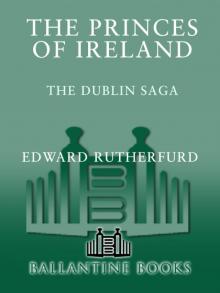 Princes of Ireland
Princes of Ireland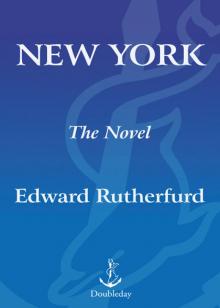 New York
New York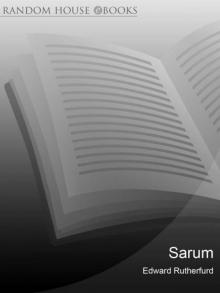 Sarum
Sarum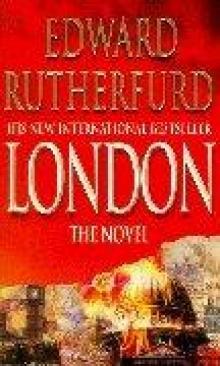 London
London Russka: The Novel of Russia
Russka: The Novel of Russia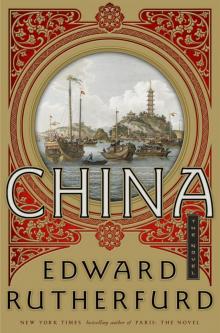 China
China Paris
Paris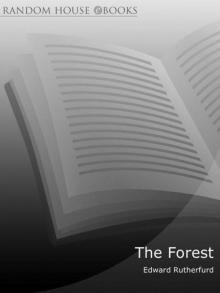 The Forest
The Forest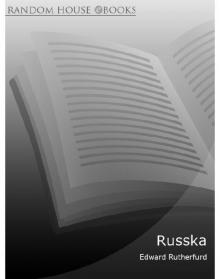 Russka
Russka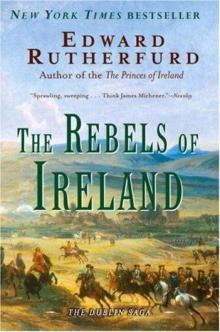 The Rebels of Ireland: The Dublin Saga
The Rebels of Ireland: The Dublin Saga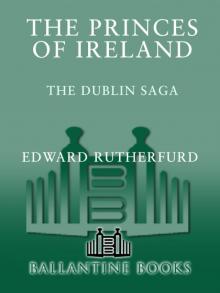 The Princes of Ireland
The Princes of Ireland Paris: The Novel
Paris: The Novel